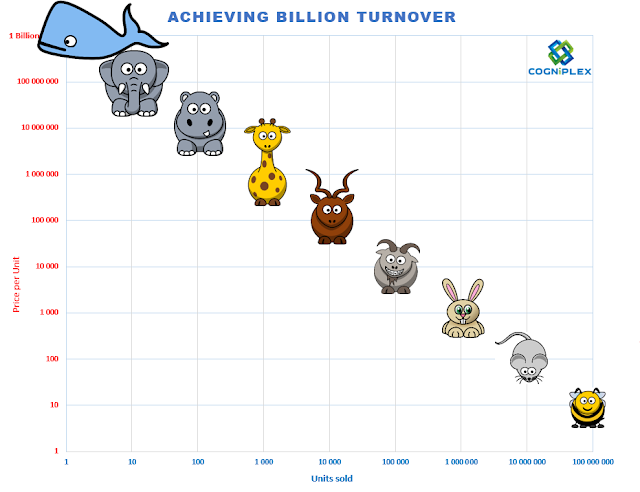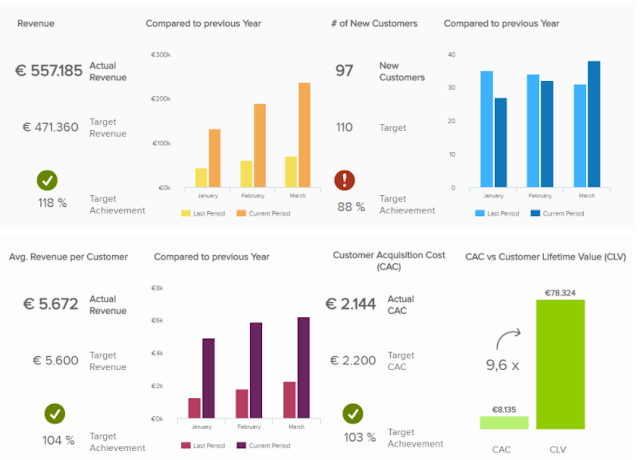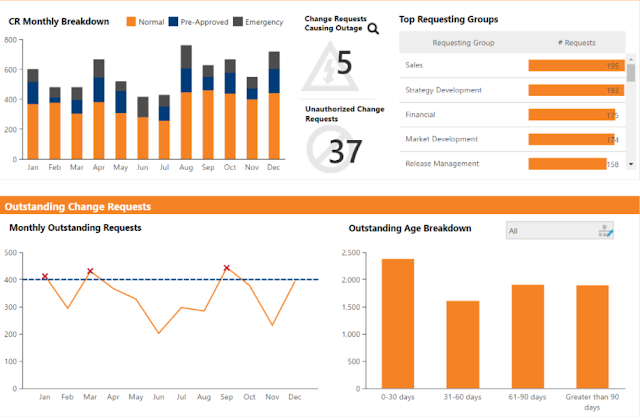30 Different Ways to Build a Billion Business
24 Oct 2017
Abstract
This series of blog posts focus at a high-level on various approaches to increase company revenue/turnover and discusses each in brief. Some well-known international and potentially lesser known examples from South Africa or neighbouring countries are included. These blog articles are aimed at business readers, ranging from corporate executives to entrepreneurs and founders searching for strategies to increases revenue. It is equally suitable for interested parties who wish improve their general knowledge around strategies and growth.
The full series will contain 3 or 4 articles. This post is Part 1
Estimated reading time: 7 min or less
0. Background
The inspiration for this article comes from a blog post by venture capital partner, Mr Christoph Janz, posted in 2014, "Five ways to build a $100 million business", and subsequent articles here and here.
Mr Janz' article was itself an expansion on an earlier article by Mr Boris Wertz, "The only 2 ways to build a $100 million business".
While some of the concepts included in Mr Janz's articles were used as the basis for this series, there are some key differences:
The inspiration for this article comes from a blog post by venture capital partner, Mr Christoph Janz, posted in 2014, "Five ways to build a $100 million business", and subsequent articles here and here.
Mr Janz' article was itself an expansion on an earlier article by Mr Boris Wertz, "The only 2 ways to build a $100 million business".
While some of the concepts included in Mr Janz's articles were used as the basis for this series, there are some key differences:
- The original focussed purely on the e-Commerce & SaaS markets, while this series of posts go much broader into different industries,
- We have adjusted for local conditions and markets,
- The original article was limited to 5 ways, this expands up to 30 ways.
1. Introduction
There are different ways to turn your business into a Billion turnover (or more) company. In this article, we will delve deeper into some of the factors and considerations at play. This series of blog posts will look at various companies in a variety of industries. The discussion is therefor not limited to start-ups, unicorns, or e-commerce.
While most of the examples in this article substantially focus on the topic of billion (Rand) revenue/turnovers, this does not mean that you should stop reading if:
- Your company is pre-revenue or turnover is e.g. 7 million …i.e. well below a Billion;
- You are a brick-and-mortar company or not a brick-and-mortar company;
- Your company is already well in excess of a Billion;
- Your company uses another base currency e.g. U$ or € and not ZAR;
Various principles outlined in this article can still be applied to great effect in order to increase company turnover and take the business to the next level, whatever level your next level is - even if it means reducing examples below by a zero or two, or adding a zero or 2, or ignoring or substituting the currency symbol for your own purposes.
This article is based on the assumption that there is already a fully functioning business and an active and sufficient large market. Within the chosen target market, a business would target specific demographics or groups of customers, and specific markets to serve. These groups of customers can be either be broadly classified as:
- Public sector – meaning you provide goods or services to either national government, local government, city and town councils, or State Owned Entities,
- Business or industrial customers (for purposes of this article clustered together which means you are in the Business-to-Business or B2B market), or
- Individual consumers (Business-to-Consumer or B2C market).Within these markets, there are sub-sections again, some of which we may cover later. Certain companies might target more than one group of customers, e.g. Public Sector and B2B, or both B2B and B2C. It is entirely possible that companies serving more than 1 group of customers might do so from different departments, divisions or perhaps even different subsidiaries.
In order to reach a billion in annual sales, the options are broadly as follows:
2. Change the Target Product or Market mix
For the purposes of this discussion, each of the animals in the market matrix below is a mascot representing a specific market or product segment.
Fig 1.2. Product or Market Matrix
To keep the maths simple, this diagram has illustratively been based on the logarithmic scale. Please note: international or larger U$ denominated markets may be segmented slightly different from what is indicated in the discussion below. However the principles stand – there will be some market overlap based on local market conditions:
2.1 Catch a Whale –
Landing a whale is not quite as easy as one might imagine - just ask any your circle of friends which one of them ever pulled a whole whale out of the sea. Chances are none have. In the local context this would mean landing 1 x Rand billion single year transaction.
Fig 1.3 Artwork Credit: Frits Ahlefeldt
In the local market landing a whale is difficult and rather scare – Reason being is that locally there are not that many whale catchers (companies or individuals able to land and successfully deliver on a billion Rand transaction), and also not that many whales (opportunities) waiting to be caught. However it does happen. In other countries with larger economies, more whales can be found.
Locally, and even regionally, these type of transactions would most definitely be commercial in nature – either in the Public Sector (e.g. infrastructure or construction), or alternatively private sector B2B at enterprise level (large companies or groups of companies). For example, it might include sale of assets (such as huge tracks of land, office buildings or shopping centres), or sales of companies or shares (pension funds and investments).
There is likely to be some extent of risk for the parties involved.
2.2 Bag an Elephant (or 10) –
If you are in the market to hunt for elephants, you would have to bag 10 elephants at a price of R 100 million each in one year to reach a billion.
Elephants are easier to find than whales so while these transactions are not quite abundant, they would be more common. The transaction would still most probably be commercial in nature and involve either Public Sector and or the Private sector (B2B). This would definitely target the enterprise market e.g. large-scale ERP implementations, or industrial equipment such as smelters or sale of large assets such as property or businesses.
It should be noted R 100 million is at the high-end for the ultra-rich locally when it gets to big ticket purchases. This may e.g. include luxury personal assets such as property.
2.3 Hustle up a Herd of Hippos –
100 hippos going for R10 million will bring home R 1 billion.
These transactions will commonly be B2B commercial type transactions either with the Public Sector or Private Sector, for example, IT systems developments for enterprises or medium-sized businesses or manufacturing equipment such as bottling plants or mining equipment.
This could however also include top-end luxury items for wealthy consumers such as property.
2.4 Seize a Tower of Giraffes –
A group of giraffes is occasionally referred to as a tower or more commonly, a herd. At a sales price of R 1 million you only need 1 thousand sales.
These transactions could be either B2B (business-to-business) or at the high-end of the B2C (business-consumer). Included in this list is personal or business assets such as property (land, entry level houses, townhouses, flats or personal construction projects), luxury vehicles, and business transactions such as consulting assignments, smaller industrial assets such as medium or heavy vehicles, system implementations or other professional services.
2.5 Find a forkl of Kudu
10 thousand clients at R100 000 per client
(According to Google "forkle" is an actual word, but again you can stick to herd if that feels more comfortable).
If your market is Kudus, you need to find 10 thousand transactions at R 100 000 per item. These transactions could be B2B (business-to-business) or can be B2C (business-consumer) but it should be noted they are at the middle to higher-end of the B2C market. This could include high-end electronics such as sound systems or home cinema systems, small construction projects such as bathroom renovations or new home kitchens. Also included would be business targeted services such as consulting or professional services.
2.6 Gather a flock of Goats
100 thousand customers buying R 10 0000 items from you
2.7 Fascinate a fluffle of Bunnies
Catch one million bunnies at a R 1000 per bunny
These transactions could e.g. be B2C (business-consumer) or B2B (business-to-business). Examples could be luxury consumer products such as shoes, entry-level electronics, car tyres, or services such as life insurance or short term insurance.
2.8 Corner a colony of Mice
10 million mice at R 100 per transaction
You need to catch 10 million mice, or 10 million transactions of R 100 each to reach a billion. These transactions can be B2C (business-consumer) or could also include B2B (business-to-business). Examples could include physical consumer items such as clothing, groceries, restaurant meals, services or information products such as insurance or airtime.
2.9 Catch a swarm of Bees
100 million bees at R 10 per transaction
If you target bees, to reach a billion you would need 100 million transactions at R 10 each. R 10 transactions happen daily all around us. These transactions can be B2C (business-consumer) or maybe even B2B (business-to-business).
Examples could include e.g. consumer goods such as grocery items such as margarine, illuminating paraffin (approximately max retail price at time of going to press), or airtime.
= = = = =
Moving on to another consideration ...
In addition to the above, the following options can be considered on a case-by-case basis to increase your turnover. It should be note that these strategies may be influenced by market or other economic or industry specific variables:
In addition to the above, the following options can be considered on a case-by-case basis to increase your turnover. It should be note that these strategies may be influenced by market or other economic or industry specific variables:
3. Change the sales price
3.1 Increase price
McKinsey & Co. studied the Global 1200 (top 1200 companies in the world) and found that if they raised prices by just 1% — subject to demand remaining constant — profits would go up on average by 11% (hbr.org/2012/07/use-pricing-strategy-to-boost).
This is not merrily a cases of randomly pushing prices up. Prior to making any changes to the pricing structure we recommend conducting a benchmarking exercise to determine competitors’ pricing. This would also include a determination of value-for-money and perceived value/quality inherent in your own product or service offering vis-à-vis your competitor’s products or services. If your pricing is significantly lower than that of competitors, and/or if you offer more value or quality compared to competitors, then you could be losing out due to offering lower prices.
Other considerations include:
- Consider price elasticity of demand. If demand is inelastic, meaning demand does not reduce when prices increases, there might be scope for increases,
- Availability of complimentary products – if you produce butter while your competitors sell margarine (or any other almost perfectly acceptable substitute for your product), increases in your pricing might send customers to the competition.
3.2 Reduce price
Fig 1.4 Steam Library
Consider the case of Steam - one good example that gamers will know about: Steam is a multi-player platform developed by Valve Corporation. It is used to distribute computer type games and related media online, a type of specialised e-Commerce platform. During 2009 Steam held a sale for a specific computer game title, during which time prices were heavily discounted. When they dropped prices by 75%, this resulted in a 1470 % increase in sales. Another undisclosed game title achieved a 36 000 % jump in sales, however the discount applicable for that specific sale was not disclosed.
Another example is offering price reductions on available, but unused capacity. This equates to e.g. reducing the price of bus tickets outside of prime rush hour periods or after say 21:00 at night. If the bus runs the whole route in any event, reducing the price might result in more bums on seats (subject to demand at that time). A key consideration is that fixed cost is still covered (possibly during normal hours) and variable costs (if any) is marginal, or still covered by the reduced pricing. Also refer to the Ster Kinekor movie theatre example mentioned later under loyalty programs.
It should be noted that in instances where price deductions do not automatically result in volume increases, any ill-considered reduction can have a significant and negative impact on gross profit. Again this exercise would have to be approached with caution, and be limited to small decreases. This will require a benchmarking of competitors’ pricing, determining demand curves, as well as a rigorous assessment of margins and contribution prior to implementation.
3.3 Change currency & export
While selling products or services inside SA (or most other countries), vendors are typically limited to charging domestic customers in their local currency. If however, you are able to compete cost efficiently overseas or in neighbouring countries (after taking into consideration additional costs of export, transport, storage and handling), valuable foreign exchange can be earned in the process.
Example: Local product sells for R 120, but the equivalent product sell for $9.95 in neighbouring countries. If the additional expenses are not significantly more for the exported product, the sales price achieved could be R 132.41 vs R 120 (based on U$ vs ZAR exchange rate as at 16 Oct 2016).
3.4 Upsell
A good example of upselling occurs when purchasing a new motor vehicle. The basic car on offer might come with 4 tyres, standard seats, an adequate engine and a steering wheel. And maybe a five speed fan on entry level vehicles. The sales person will then take the buyer through a long and confusing list of upgrades, add-ons, or other more expensive items to “bling” up the vehicle including warrantees, guarantees, motor plan extensions etc.
Fig 1.5 Artwork Credit: Mark Anderson
If the seats come standard as material, the upgrade might be leather, with a premium price e.g. for super-soft suede. The vehicle will come in standard unimaginative colours, but metallic paint will cost more. Ditto if there is a basic radio, the upgrade might have GPS touch screen, while the top-of-the-line might come with a premium surround-sound and DVD system.
The profit margins on add-ons are typically higher than on the basic item.
3.5 Value-based pricing
Value-based pricing is a pricing strategy which sets prices primarily, but not exclusively, based on the perceived or estimated value of that product or service to the customer, rather than according to the cost of the product or historical prices.
Consider the customer’s willingness to pay, is typically contingent on the sum of the perceived benefits which accrue to the customer on purchase of your product. When seen from a customer point-of-view, if buying your product is a no-brainer, it could mean the combined value-offering of all the features presents a high ratio of value for money when compared to the price he or she has to pay to acquire it.
Summary (Part 1)
In Part 1 of this series of blog posts we have briefly reviewed the roles of:
- Product & Market Mix
- Price
Both of these factors play a very significant role in achieving target Revenue. While Product & market mix sets the foundation, Pricing is affected by the demand for the product, determines Profit, and influences the Volume of Sales.
Did you gain any new insights from this list regarding the product / market mix or pricing? Which other strategies specific to pricing or mix have you used to increase revenue?
Please note there are more blog posts to follow. We hope and trust that you found this information useful. If you liked this blog post, please share or tweet or repost to others who may also be interested in reading this article.
© Cogniplex 2017



















